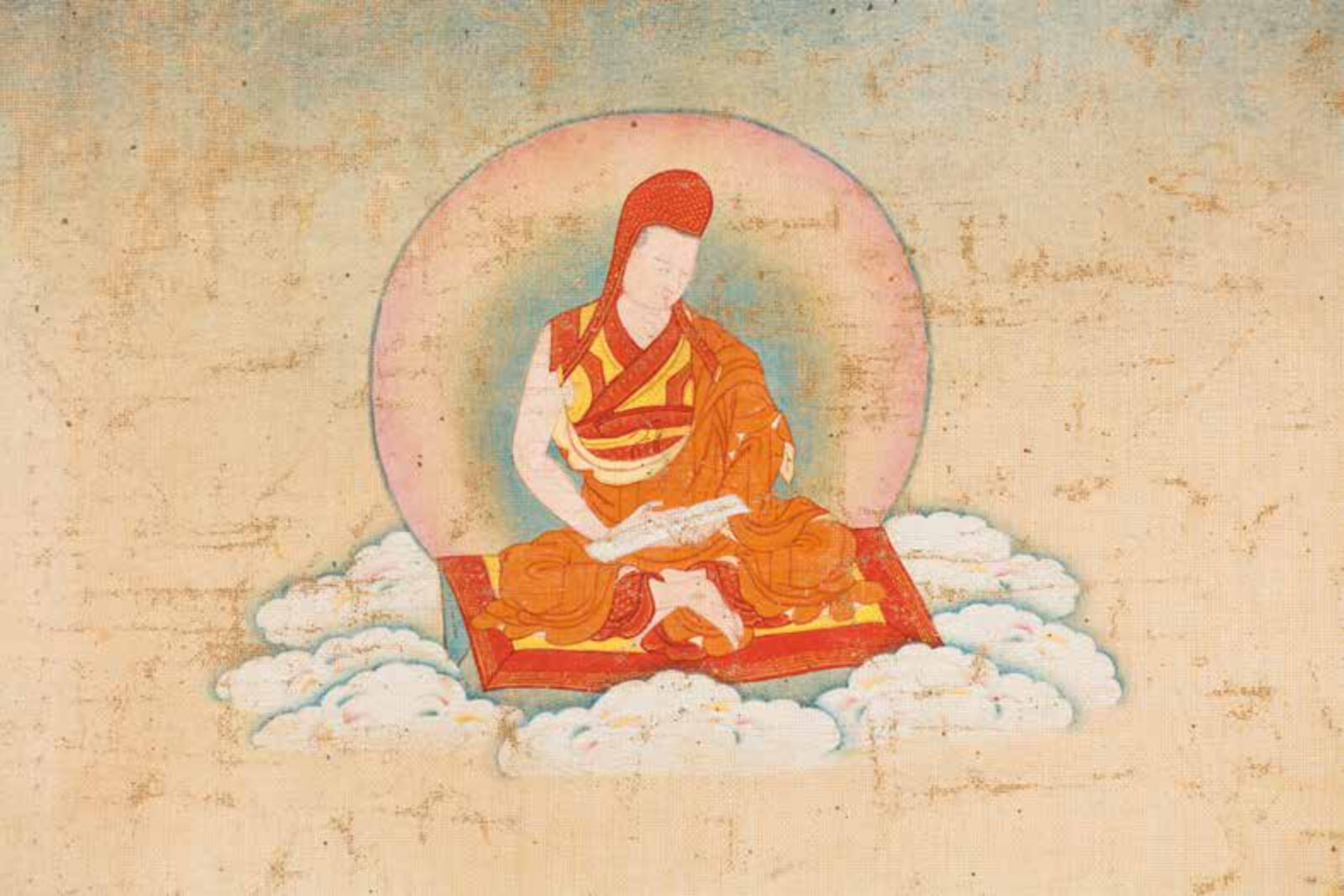
King of Shambhala; Eastern Tibet (Karma Gardri painting style); 18th century; mineral pigments on cloth; Rubin Museum of Art; C2004.5.6 (HAR 65297)

King of Shambhala; Eastern Tibet (Karma Gardri painting style); 18th century; mineral pigments on cloth; Rubin Museum of Art; C2004.5.6 (HAR 65297)
Buddhism defines time as the measurement of change. The Kalachakra system presents three cycles of time, and its teachings assert that change can be measured by the motion of the heavenly bodies or the number of breaths we take. Both are driven by the uncontrollable force that Buddhism calls karma—the inertia that perpetuates heavenly motion and the compulsiveness that perpetuates our habitual behavior. Karma—both universal and individual—is therefore the real enemy, not time. Even more harmful is the ignorance with which, over time, we compulsively act out our neurotic social and individual karmic tendencies, producing all the problems we experience throughout life.
The cycle of lifetimes, one after another, filled with problems and culminating each time in death, is known as samsara. Its persistent march onward is marked by our perceived enemy, the passage of time. But the Kalachakra teachings offer a profound method for overcoming the ravages of time due to karma and ignorance. Instead of samsaric lifetimes ending with death, we can end our samsaric existence with the attainment of liberation and enlightenment. We can replace a dismal future, filled with unending problems, with a blissful, bright future, filled with unending compassion, wisdom, and the ability to guide others to enlightenment.
But what do we mean by the future? In contrast to Western conceptions of past, present, and future, Buddhism speaks of what is not yet happening, what is presently happening, and what is no longer happening. Your death is not yet happening; you reading this article is presently happening; your childhood is no longer happening. Your childhood isn’t sitting offstage, having played its part; your death isn’t sitting in the wings, waiting to come onstage. You reading this article won’t go somewhere else once a new scene starts in your life. Similarly, your enlightenment isn’t sitting somewhere in a place known as the future, nor is it residing deep inside your head. We will only attain enlightenment by ridding ourselves of the ignorance that drives us to compulsively act out our neurotic karmic tendencies over and again.
Attaining enlightenment is therefore really a battle against karma and ignorance, a battle against the forces of time. It takes place in Shambhala, literally “the land of bliss” and the source of the Western concept of Shangri-La, represented in James Hilton’s novel Lost Horizon (1933) as a spiritual paradise found in an inaccessible, hidden valley in Tibet. Kalachakra represents Shambhala and this ultimate battle on multiple levels—external, internal, and spiritual. This is in keeping with the Kalachakra vision of the universe, where the body and the spiritual path run in parallel. What happens in the universe and the body occurs under the influence of karma and ignorance, marked by the samsaric cycles of time. What happens on the spiritual path occurs under the influence of compassion and wisdom, bringing an alternative to these samsaric cycles: enlightenment.
Externally, in the land of Shambhala, a battle will take place many years from now. The forces upholding spiritual values will defeat an invading barbaric horde bent on destroying all opportunities for spiritual growth. Their defeat will mark the end of an age of darkness and herald the start of a new golden age. Internally, Shambhala is the heart chakra, the location of our life-sustaining energy-winds. Here a battle is waged against the invading hordes of sickness and won by the forces of medicine and a healthy lifestyle. Overcoming sickness, we attain a golden age of perfect good health.
On both the external and internal levels, the so-called winds of karma drive the invasions, passing through repeated cycles of time. On the spiritual level, Shambhala is the subtlest level of the mind, the clear light mind. When we can access and reach this deepest Shambhala, we will be able to employ sophisticated spiritual methods to stop the flow of the winds of karma. We will then attain enlightenment—the state beyond the control of samsaric time.
The defeat of the hordes of invading barbarians, sickness, and winds of karma has not yet happened, and like tomorrow, what will happen during these battles is not determined or fixed. It is certain, however, that tomorrow will happen, though when it begins depends on our location on earth. But in the case of these external, internal, and so-called alternative spiritual battles, it is not certain they will take place, let alone when they will occur. After all, what is not yet happening is not sitting somewhere already fixed, waiting for its turn to be presently happening. The future isn’t happening now.
What is not yet happening can only arise dependently on cause and effect. To defeat an external invading horde of barbarians, our society needs to come together in peace and harmony to present a united front. To defeat an invading horde of sickness, our bodies need to bring all their systems into balance so they work together to ward off disease. To defeat the deepest invading horde of the winds of karma, our minds need to gather all the spiritual forces of the Kalachakra path, as united they have the greatest strength.
What is not yet happening—the future—lies in our hands. If we work to bring harmony to our societies, bodies, and minds, we can make what is presently happening be for the benefit of all.

Dr. Alexander Berzin is a scholar, translator, and teacher of Tibetan Buddhism who received his doctorate from Harvard University and lived in Dharamsala, India, for twenty-nine years. The author of seventeen books, including Relating to a Spiritual Teacher and Taking the Kalachakra Initiation, Dr. Berzin founded the Berzin Archives in 2001 as part of his lifelong commitment to building a bridge between the traditional Buddhist and modern worlds. Its recently relaunched website is studybuddhism.com.
Get the latest news and stories from the Rubin, plus occasional information on how to support our work.